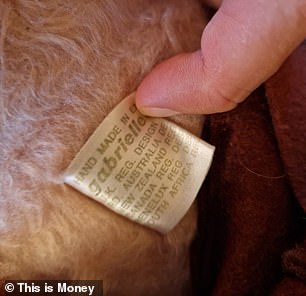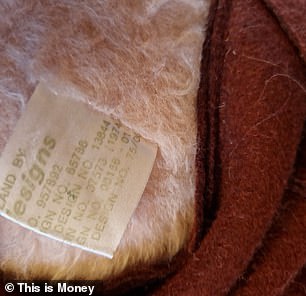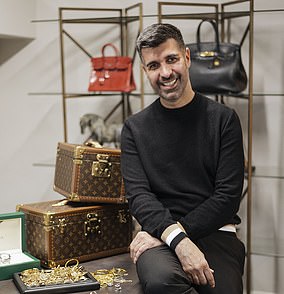Is my 50-year-old Paddington teddy bear worth much? DAN HATFIELD answers
I have a Paddington teddy bear from when I was little; I, my children and now my grandchildren enjoyed it.
It’s a little rough around the edges, missing a toggle, but otherwise in good condition.
We’d like to keep it in the family, but I always wonder if it’s worth a small fortune and if I should stash it away somewhere safe, instead of the toddlers taking it to their make-believe tea parties.
And is it worth repairing? Lorraine, via email.
Paddington in Peru: The adorable bear is back for his third big-screen adventure – and this original bear has been in our readers’ homes since the 1970s
Dan Hatfield, our local valuation expert, answers: I have such fond memories of Paddington Bear.
So much so that for years I tried valiantly to develop a taste for marmalade sandwiches, in solidarity with my Peruvian friend.
Ultimately, I admitted defeat on that front, but my affection for the bear itself remains completely intact.
So I’m excited to appraise this beloved bear, especially since then Paddington in Peru – the third part of the popular big-screen series – is out today.
But let’s go back to 1958, when the world was first introduced to Paddington when the book: A bear named Paddingtonwritten by British author Michael Bond, was published.
Britain quickly fell in love with this well-meaning, hapless bear, whose innocent curiosity and sweet nature endeared him to children and adults alike.
Paddington has risen in popularity over the past decade. In addition to the film series, he also has a cartoon, in both of which Paddington is voiced by Ben Whishaw.
He even received a personal invitation to join Her Majesty Queen Elizabeth II for tea and marmalade sandwiches for her anniversary, in a hilarious sketch adored by millions.
A very British friendship, if ever there was one.
Much of Paddington’s success can be attributed to Gabrielle Designs teddy bears like yours, which brought him to life for new generations when they first appeared in the 1970s.
In fact, those signature wellington boots were not part of Bond’s original design – they were added by Gabrielle Designs and proved so popular that Bond had them added to the illustrations in later editions of his book.
How did Paddington find his way from the pages of Bond’s book to our homes?
The story takes us, not to darkest Peru, but to deepest Doncaster, where Shirley and Eddie Clarkson ran a small business called Gabrielle Designs, specializing in handmade items such as aprons.
In 1972, Shirley decided to make a Paddington bear for her children for Christmas, one of whom, you guessed it, is none other than Jeremy Clarkson. It’s hard to believe, isn’t it?
One is a fluffy bundle of sweetness, and the other… well, maybe let’s just stick with the bear.
The first Paddington bears were made by hand and were such a success that the Clarkson’s received an official license to produce them in 1972.
In 1975, another company, Eden Toys, acquired the rights to produce Paddington worldwide, although the Gabrielle bears have remained collectors’ darlings for their handmade quality.
As for your particular bear, with a 1974 label, we can conclude that it is an early original Gabrielle bear, rather than a later Eden bear.
However, collectors do look for specific details that add value: the original blue coat, the hanging “take care of this bear” label, and the extra things like intact switches all play a role.


Gabrielle Designs: This label shows that it was made in England in 1974

Family Ties: Jeremy Clarkson’s mother Shirley made a Paddington teddy bear in 1972… and its popularity soared in the years that followed
Since your copy is missing a switch, the original label is missing, and it is not one of the first production runs, I estimate its value at around $20 to $30.
With the label and switch it could have been worth closer to £50-£60.
As for repairs, if your motive is to extend the life of this beauty so that your family can enjoy it and pass it on to generations to come, I would absolutely do that.
But when it comes to adding monetary value to your bear, I wouldn’t do that, as it’s the missing tag and switch that would have secured you the extra value – and the restoration costs can often outweigh the potential new value.
So while your Paddington won’t fund a trip to see where it all began in darkest Peru – in fact it could barely fund a ticket from Paddington Station with the prices of train tickets – it remains a wonderful piece of family history and a British institution in its own right.
Now I have to run, I have a movie to see at the cinema, but I have popcorn under my hat, instead of a marmalade sandwich.
Some links in this article may be affiliate links. If you click on it, we may earn a small commission. That helps us fund This Is Money and keep it free to use. We do not write articles to promote products. We do not allow a commercial relationship to compromise our editorial independence.

